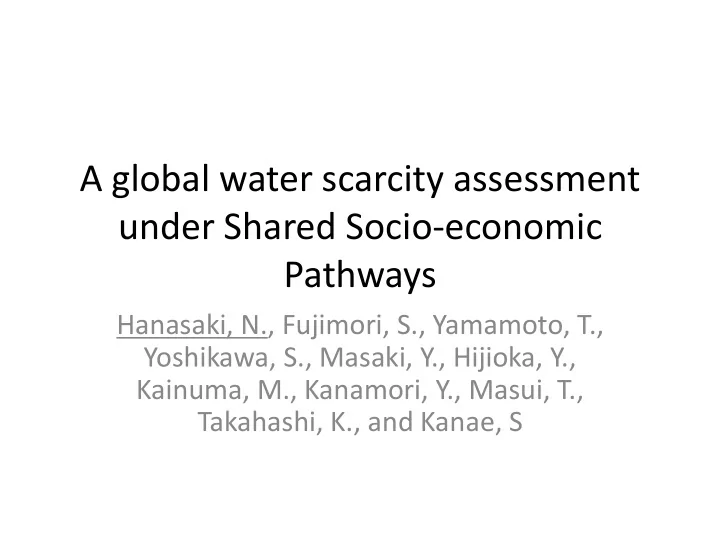

A global water scarcity assessment under Shared Socio-economic Pathways Hanasaki, N., Fujimori, S., Yamamoto, T., Yoshikawa, S., Masaki, Y., Hijioka, Y., Kainuma, M., Kanamori, Y., Masui, T., Takahashi, K., and Kanae, S
Outline Two papers were submitted to Hydrology and Earth System Sciences. Hanasaki, N., Fujimori, S., Yamamoto, T., Yoshikawa, S., Masaki, Y., Hijioka, Y., Kainuma, M., Kanamori, Y., Masui, T., Takahashi, K., and Kanae, S.: A global water scarcity assessment under Shared Socio-economic Pathways: Part 1 Water use, Hydrol. Earth Syst. Sci., 2012. Hanasaki, N., Fujimori, S., Yamamoto, T., Yoshikawa, S., Masaki, Y., Hijioka, Y., Kainuma, M., Kanamori, Y., Masui, T., Takahashi, K., and Kanae, S.: A global water scarcity assessment under Shared Socio-economic Pathways: Part 2 Water availability and scarcity , Hydrol. Earth Syst. Sci., 2012. Draft papers are available (hard/soft copy) .
Highlights of Part1 Shared Socio-economic Pathways SSPs: New socio-economic scenarios for global change study (post SRES) SSP Description SSP1 Sustainability SSP2 Middle of the Road SSP3 Fragmentation SSP4 Inequity SSP5 Conventional Development Similar to SRES, major socio-economic factors are quantitatively available GDP (global total) Population Electricity production
Highlights of Part1 How people use water in each SSP? Almost no description on water use in qualitative/narrative scenarios of SSPs Tried to develop a water use scenario COMPATIBLE with SSPs. 1. Developed simple (but robust) models on water use = × Industrial Water Electricit y intensity Scenario-dependent parameter Quantitative scenarios from SSPs 2. Developed THREE parameters for each model INDEPENDENTLY from SSPs Ex: Scenarios on industrial water intensity Low efficiency Mid efficiency High efficiency High efficiency Rate historically observed in China/Thailand, Japan, and Israel
Highlights of Part1 How people use water in each SSP? 3. Linked three parameters and five SSPs focusing on narrative scenarios SSP Description Technological change SSP1 Sustainability Rapid SSP2 Middle of the Road Moderate SSP3 Fragmentation Slow Industrial Water = × SSP4 Inequity Rapid/Slow Electricit y intensity SSP5 Conventional Development Rapid Low Eff Mid Eff High Eff
Highlights of Part1 Water use scenarios Global total industrial water withdrawal Change in industrial water withdrawal (2055 - 2000)
Highlights of Part1 Water use scenarios Agricultural scenarios: Irrigation area Crop intensity Irrigation efficiency Industrial water withdrawal scenarios Domestic water withdrawal scenarios
Highlights of Part2 Is water available? In Part 1 “potential water demand” was projected. Investigated the projected amount of water is hydrologically available. What would be the future climate? Scenario matrix GCM MIROC-ESM-CHEM HadGEM2 ESM GFDL ESM2M Time 1971-2000 (base period) 2011-2040 2041-2070 2071-2100
Highlights of Part2 Global water resources model H08 1. High spatial resolution (0.5 °× 0.5 ° ) 2. High temporal resolution (daily) 3. Interaction between natural water cycle and human activities Human 0.5 °× 0.5 ° 0.5 Nature 67,420 cells cells Regional simulation (e.g. Chao Phraya River)
Highlights of Part2 How can we know “water scarcity” Method used in this study Water withdrawal simulation - Withdraw from river - Daily interval - Rivers can be depleted, and withdrawal can fall below demand 365 ∑ withdrawal demand DOY availability = = DOY 1 CWD 365 ∑ deficit demand DOY = withdrawal DOY 1 Dec Jan Water scarcity: CWD<50 %
Highlights of Part2 Water scarcity assessment Change in CWD ratio Stress increases including regions mean annual runoff increases Climate policy has limited effect for overall structure of water scarcity? Stressed population Population living in grid cells with the condition of CWD < 50%
Summary Developed water use scenario compatible with SSPs. Assessed water availability and use globally. As far as we know, this is the first such study. Two papers will be soon available online as discussion paper. During Open Discussion period, anyone can comment to these paper. Next steps - Adaptation options - Working together with AIM/CGE Next steps with YOUR help - Better water use scenario (historical data, evaluating technical feasibility) - Further nexus (mitigation, LCS, land use, agriculture studies, and more)
Highlights of Part2 Why don’t you use WWR index? Conventional method Annual river discharge change AnnualWith drawal Increases in many parts of the world WWR = AnnualRive rDischarge Water scarcity: WWR>40 % Sometimes misleading results: where mean annual runoff increases, WWR automatically decreases (indicating water scarcity is alleviated) Runoff change WWR change
Highlights of Part2 Climate policy has only little effect? Figure 16 Percentage of global population living in grid cells categorized as Figure 15 Region-wise total global population living in grid cells where CWD < Significant Degradation (ΔCWD< -0.05, red), Moderate Degradation (- 0.5. The bars in left and right show the results of no climate policy and with 0.05≤ΔCWD<0, orange), and Alleviation or no change (0≤ΔCWD, blue). Each climate policy respectively. category was subdivided into three by the change in the CWD recorded as Highly Stressed (CWD<0.5, dark), Moderately Stressed (0.5≤CWD<0.8, medium), and Less Stressed (0.8≤CWD, pale). The bars in left and right show the results of no climate policy and with climate policy respectively.
Recommend
More recommend